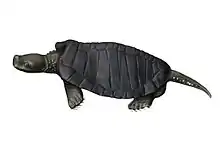| Meiolaniformes Temporal range: Early Cretaceous to Holocene | |
|---|---|
.jpg.webp) | |
| Meiolania | |
| Scientific classification | |
| Domain: | Eukaryota |
| Kingdom: | Animalia |
| Phylum: | Chordata |
| Class: | Reptilia |
| Clade: | Pantestudines |
| Clade: | Testudinata |
| Clade: | Perichelydia |
| Clade: | †Meiolaniformes Sterli and de la Fuente, 2013 |
| Families and genera | |
| |
Meiolaniformes is an extinct clade of stem-group turtles, defined as all taxa more closely related to Meiolania than to Cryptodira and Pleurodira.[1][2][3] It is known from the Early Cretaceous to the Holocene of Australia, Oceania and South America. Some Eurasian taxa have been suggested to be part of the group, but this is disputed.
The oldest member of Meiolaniformes is Australian Early Cretaceous Otwayemys.[3]
Taxonomy
The clade as currently defined contains the following taxa:
- †Chubutemys Gaffney et al. 2007[4] - Aptian, Cerro Barcino Formation, Argentina
- †Otwayemys Gaffney et al. 1998 [5]- Aptian, Eumeralla Formation, Australia
- †Patagoniaemys Sterli and de la Fuente 2011[6] Upper Campanian-Lower Maastrichtian, La Colonia Formation, Argentina
- †Peligrochelys Sterli and de la Fuente 2011[1] Danian, Salamanca Formation, Argentina
- †Trapalcochelys Sterli et al. 2013 [7] Upper Campanian, Allen Formation, Argentina
- †Meiolaniidae Lydekker 1887, Eocene to Holocene, Argentina and Australia and Oceania
It has also been suggested that Mongolochelys, Sichuanchelys, and Kallokibotion from the Late Cretaceous of Mongolia, China and Europe respectively are part of this group, but other studies find these taxa in a more derived position nearer crown Testudines. Regardless, all taxa are members of Perichelydia.[8]
References
- 1 2 Sterli, Juliana; de la Fuente, Marcelo S. (2012-12-12). "New evidence from the Palaeocene of Patagonia (Argentina) on the evolution and palaeo-biogeography of Meiolaniformes (Testudinata, new taxon name)". Journal of Systematic Palaeontology. 11 (7): 835–852. doi:10.1080/14772019.2012.708674. ISSN 1477-2019. S2CID 83804365.
- ↑ J. Sterli. 2015. A Review of the Fossil Record of Gondwanan Turtles of the Clade Meiolaniformes. Bulletin of the Peabody Museum of Natural History 56(1):21-45
- 1 2 Hans-Dieter Sues (August 6, 2019). The Rise of Reptiles. 320 Million Years of Evolution. Johns Hopkins University Press. p. 53. ISBN 9781421428680.
- ↑ Gaffney, Eugene S. (2007). Chubutemys, a new eucryptodiran turtle from the early Cretaceous of Argentina, and the relationships of the Meiolaniidae. American Museum of Natural History. OCLC 184734368.
- ↑ E. S. Gaffney, L. Kool, D. B. Brinkman, T. H. Rich, and P. Vickers-Rich. 1998. Otwayemys, a new cryptodiran turtle from the Early Cretaceous of Australia. American Museum Novitates 3233:1-28
- ↑ STERLI, JULIANA; DE LA FUENTE, MARCELO S. (January 2011). "A new turtle from the La Colonia Formation (Campanian-Maastrichtian), Patagonia, Argentina, with remarks on the evolution of the vertebral column in turtles". Palaeontology. 54 (1): 63–78. doi:10.1111/j.1475-4983.2010.01002.x. ISSN 0031-0239.
- ↑ Sterli, Juliana; Fuente, Marcelo S. De La; Cerda, Ignacio A. (April 2013). "A New Species of Meiolaniform Turtle and a Revision of the Late Cretaceous Meiolaniformes of South America". Ameghiniana. 50 (2): 240–256. doi:10.5710/amgh.16.01.2013.582. ISSN 0002-7014. S2CID 128701700.
- ↑ Sterli, Juliana; de la Fuente, Marcelo S. (July 2019). "Cranial and post-cranial remains and phylogenetic relationships of the Gondwanan meiolaniform turtle Peligrochelys walshae from the Paleocene of Chubut, Argentina". Journal of Paleontology. 93 (4): 798–821. doi:10.1017/jpa.2019.11. ISSN 0022-3360.

